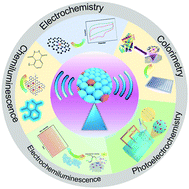Single-atom catalysts boost signal amplification for biosensing
Abstract
Development of highly sensitive biosensors has received ever-increasing attention over the years. Due to the unique physicochemical properties, the functional nanomaterial-enabled signal amplification strategy has made some great breakthroughs in biosensing. However, the sensitivity and selectivity still need further improvement. Single-atom catalysts (SACs) containing atomically dispersed metal active sites demonstrate distinctive advantages in catalytic activity and selectivity for various catalytic reactions. As a consequence, the SAC-enabled signal amplification strategy holds great promise in biosensors, demonstrating satisfactory sensitivity and selectivity with the assistance of tunable metal–support interactions, coordination environments and geometric/electronic structures of active sites. In this tutorial review, we briefly discuss the structural advantages of SACs. Then, the catalytic mechanism at the atomic scale and signal amplification effects of SACs in the colorimetric, electrochemical, chemiluminescence, electrochemiluminescence, and photoelectrochemical biosensing applications are highlighted in detail. Finally, opportunities and challenges to be faced in the future development of the SAC-enabled signal amplification strategy for biosensing are discussed and outlooked.



 Please wait while we load your content...
Please wait while we load your content...